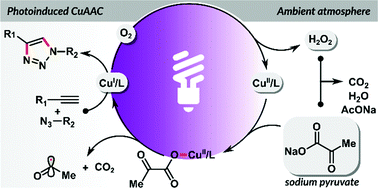Biocompatible photoinduced CuAAC using sodium pyruvate†
Abstract
Sodium pyruvate, a natural intermediate produced during cellular metabolism, is commonly used in buffer solutions and media for biochemical applications. Here we show the use of sodium pyruvate (SP) as a reducing agent in a biocompatible aqueous photoinduced azide–alkyne cycloaddition (CuAAC) reaction. This copper(I)-catalyzed 1,3-dipolar cycloaddition is triggered by SP under UV light irradiation, exhibits oxygen tolerance and temporal control, and provides a convenient alternative to current CuAAC systems, particularly for biomolecular conjugations.



 Please wait while we load your content...
Please wait while we load your content...